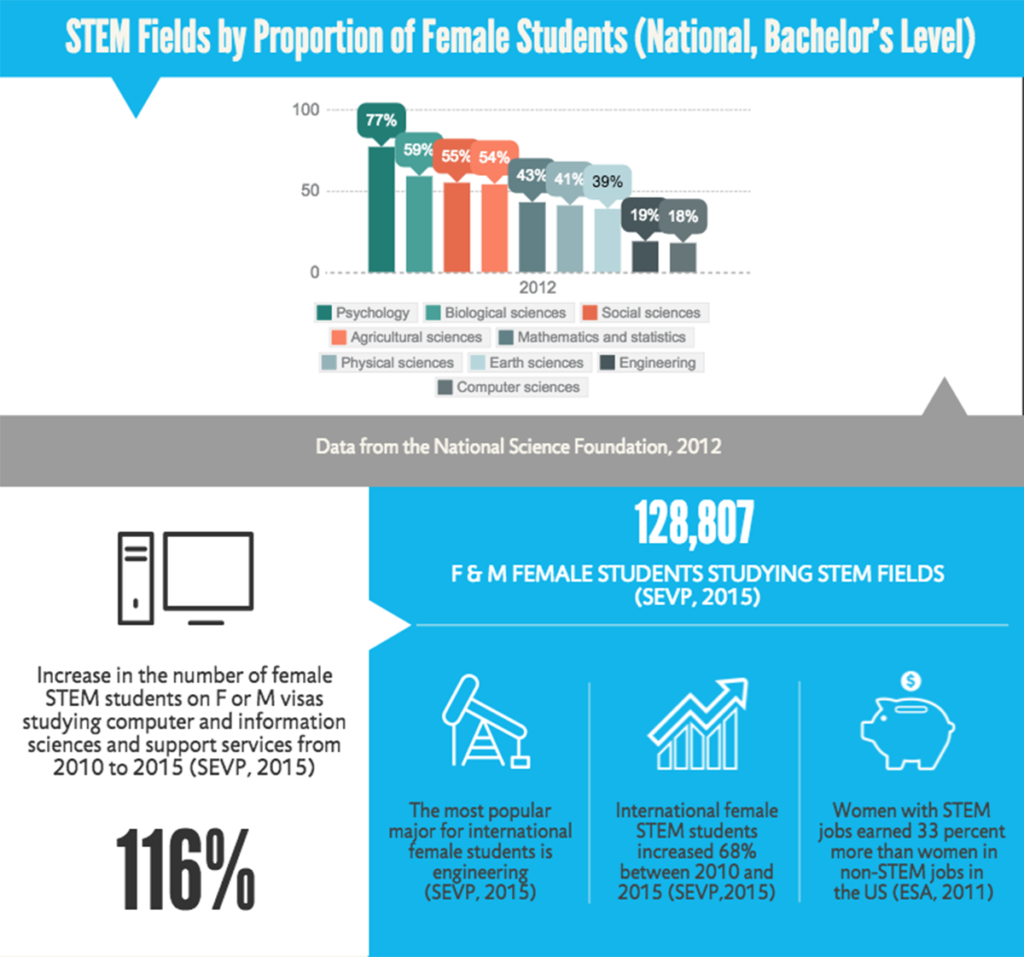International Women: The Key to Gender Parity in U.S. Science & Engineering Departments?
Paul Schulmann, Senior Research Associate, WES
The gender gap among students studying engineering and computer sciences in the U.S. is both chronic and well documented. What is less clear is a way forward. However, one February 2015 report by U.S. Immigration and Customs Enforcement’s Student Exchange and Visitor Program (SEVP) may provide some clues.
The report noted that between 2010 and 2015, the total number of international women studying STEM subjects on F1 and M2 visas has increased more than 68 percent in total. It increased a full 78 percent at the bachelor’s level. Crucially, the most popular STEM majors among female international students are engineering and computer sciences. In fact, SEVP data show that, between 2010 and 2015, the numbers of international women studying computer sciences grew by 116 percent.
Per IIE data covering the same period, these numbers significantly outpaced both the 34 percent3 growth of international enrollments for all fields and genders, and the 61 percent growth at the bachelor’s level. Growth in STEM enrollment among international women also stands in contrast to increases in the total number of women studying science in the U.S. which have occurred only in proportion to trends in total college enrollment.
These statistics shine a light on an interesting possibility: As large numbers of international women enter underrepresented STEM fields in the U.S., they will increase their gender’s visibility in these roles, and may function as de facto role models for their domestic counterparts, creating a more welcoming environment for other women simply by dint of their presence.
Research shows that both numbers and role models are important. A 2011 U.S. Department of Commerce report cited a “lack of female role models, gender stereotyping, and less family-friendly flexibility” as factors limiting growth in the number of U.S. women pursuing STEM studies.
Other research, including a widely cited, six-year longitudinal study from the University of Washington, has shown that increased female presence in the hard sciences could also help mitigate feelings of isolation or intimidation that factor into women’s decisions to leave these disciplines. Increased numbers of women could likewise help to overturn the cultural barriers that stereotypes engender, particularly in the fields of computer science and engineering. “If girls do not see computer scientists and engineers as people with whom they feel similar, they may be more reluctant to enter these fields,” note the authors of one such study on stereotypes. “The mere fact of having underrepresentation can perpetuate future underrepresentation.”
How wide is the STEM gender gap in the U.S.?
Notably, the disparity in science education enrollments by gender persists primarily in the aggregate. At the level of specific STEM disciplines, the story is much different. Women have a dominant presence in some fields at some levels of study, and low representation in others. In 2012, for instance, women at the bachelor’s level earned 59 percent of biological sciences degrees, 18 percent of computer science degrees, and 19 percent of engineering bachelors’ degrees – a proportion that, according to the NSF, had actually diminished (albeit slightly) in the years since 2002.
Although the proportion of women earning engineering and computer science degrees improves at the graduate level, where approximately one quarter of degrees are awarded to women, a 3:1 ratio of male to female enrollments indicates that parity remains a long way off.
And progress has stalled despite the fact that researchers, government and philanthropies have, for many years, thrown hundreds of millions of dollars at the challenges of increasing STEM proficiency among U.S. students, and at driving up participation among women and girls.
Why does gender matter?
An extensive body of research shows that diversity has an impact on the quality of scientific research in any field. Scientists of different racial, socioeconomic, and gender bring different and valuable perspectives, and help frame research so that it is more broadly relevant. Women’s attrition from the fields of computer science and engineering has economic consequences as well, both in terms of individual women’s lives and more broadly. According to a report by the U.S. Department of Commerce Economics and Statistics Administration (ESA), women employed in non-STEM fields in the U.S. earned 21 percent less than men in 2009, compared to a 14 percent gap for all STEM employment. The gap narrowed to seven percent in the field of engineering.
Additionally, women represent only one quarter of the STEM workforce despite comprising half of the labor force. In sectors (governmental and private) that already suffer from a shortage of qualified STEM professionals, a lack of women could exacerbate this shortfall.
Addressing these gaps and impacts means, among other remedies, ensuring that the pre-workforce pipeline (a.k.a., institutions of higher education) includes a substantial number of women from all backgrounds. Data suggest that these international women will continue coming to the U.S. to study as long as the opportunity remains viable and desirable. Any serious national effort to increase the overall number of women studying sciences should look beyond our borders. Female international students, who study in the most underrepresented fields in significant numbers, are part of the solution. Enterprising universities, organizations and the government should seize the opportunity and work collaboratively to address the gender disparity.
1. F visas are a type of non-immigrant student visa that allows foreigners to pursue education (academic studies and/or language training programs) in the United States.
2. M-1 visas are a type of student visa reserved for vocational and technical schools.
3. Excludes students on Optional Practical Training (OPT) and those enrolled in “Non-Degree” programs
